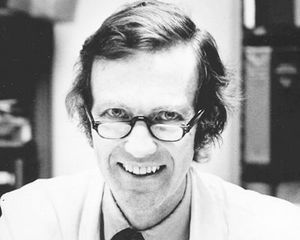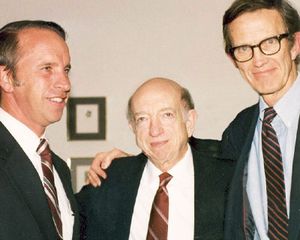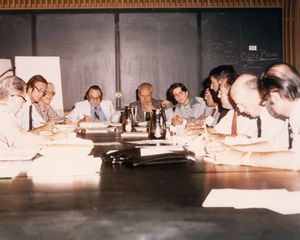Matthew Dinsdale Davis, MD, known as “Dr. Davis,” was a wonderful mentor — not just individually, but to both the retina community and the clinical trials community.
Because of his unassuming presence his accomplishments may not be well-known, even though he received the Howe Medal from the American Ophthalmological Society and the Laureate Award from the Academy. His passions were his family and his work, and he continued as emeritus professor at the University of Wisconsin into his 90s.
Dr. Davis attended the Lawrenceville School, a prep school in New Jersey, and returned home to Madison, Wis., for his undergraduate degree at the University of Wisconsin-Madison. He received his medical degree from the University of Pennsylvania and returned home again to complete his ophthalmology residency in 1955 at the University of Wisconsin Hospital, although that was interrupted for two years of active duty in the U.S. Naval Reserve.

Matthew Dinsdale Davis, MD
After completing his residency, Dr. Davis said his father, an ophthalmologist in Madison, recognized that retina was the coming field in ophthalmology and suggested that Dr. Davis apply to Dr. Charles Schepens at Massachusetts Eye and Ear Infirmary to become one of his first fellows. He had the goal of learning how to use the indirect ophthalmoscope and repair retinal detachments.
For the first four months of the fellowship, Dr. Davis had trouble using the indirect ophthalmoscope with any facility. He finally decided that if he could not learn to use the indirect ophthalmoscope effectively by Thanksgiving, he would give the whole thing up. Almost miraculously, a day or so before Thanksgiving, it all came together, and he continued his retina training.
Once again, Dr. Davis returned to his hometown where he practiced as a retinal specialist. He joined the faculty at the University of Wisconsin, where in 1970 he became chairman of the newly formed department of ophthalmology. Dr. Davis’ life changed direction dramatically in 1971 when he successfully obtained a grant to conduct the Diabetic Retinopathy Study (DRS).
It not only changed his life, but his efforts in designing the DRS laid the groundwork for how clinical trials are carried out today. Because this was the first major multicenter randomized clinical trial in ophthalmology, there was no template for conducting such a trial. At that time, there were a few large National Institutes of Health randomized trials, such as the University Group Diabetes Project, that provided some guidance.

Three close friends: Dr. Davis (right) with Dr. Arnall Patz (center) and the author, Dr. Rick Ferris.
For the most part, Dr. Davis, along with the help of Genell Knatterud, who ran the coordinating center for the DRS at the University of Maryland, and Fred Ederer, who was the project officer for the study at the National Eye Institute, had to develop the study manual of procedures from scratch. Although commonplace today, following a study protocol was new to the investigators of the time.
Dr. Davis’ ability to listen to everyone was critical in orchestrating the compromises necessary to develop a consensus on how to standardize all the varied clinical and methodologic procedures necessary for a well-designed randomized multicenter clinical trial. For example, the outcome variable for the DRS was defined as “blindness” in the grant application. The original draft manual of procedures defined blindness as 20/200 visual acuity or worse using a Snellen chart. The level of visual acuity was to be the smallest line with one or fewer mistakes.
Obviously, this needed to be changed, since the 20/200 line was only the letter E. Furthermore, it seemed more appropriate to have a more severe level of vision loss as the primary outcome. It also seemed important to have an outcome that included some persistence of blindness because vitreous hemorrhages could clear. This led to the primary outcome being visual acuity less than 5/200 at two consecutive four-month visits.
Dr. Davis patiently worked with the study group to develop the first visual acuity protocol. This required completely new charts as well as a detailed refraction and visual acuity testing protocol. But developing a written manual of procedures was only the first step. Dr. Davis recognized that the clinical sites were not accustomed to following study protocols and he instituted site visits to each clinic. He was correct about the need for emphasis on standardization. Clinic staff members were accustomed to doing things their way. One clinic had a visual acuity lane that was 17 feet long instead of the protocol defined 20 feet. When asked why, the answer was that the room was only 20 feet long.
Change was difficult. In addition, the protocol had the study ophthalmologists doing the refractions and visual acuity exams. The site visits demonstrated that this was not a good idea. It was apparent that these visual acuity examinations would not be reproducible across clinics or even within clinics. The time pressures on the study ophthalmologists would not lead to consistent outcomes, even if they all agreed in writing to follow standard procedures. Training technicians to do the visual acuity protocol, may not have led to the best possible visual acuity at each visit, but it did lead to reproducible acuities. Of all the protocol innovations, this one may have been the most important. It is hard to imagine clinic ophthalmologists doing the refractions and visual acuities in clinical trials today.
Dr. Davis worked with the study principal investigators to develop a manual of operations that was both practical and detailed. His patient personality, with personal visits to each clinic, was critical to getting these leaders to change their routines with the goal of standardization across clinics.

Attendees of the 1974 Diabetic Retinopathy Study, Data Safety Monitoring Committee Meeting (clockwise): Drs. Edward Norton, Matthew “Dinny” Davis, Genell Knatterud, Jerome Cornfield, Cristian Klimt, Argye Hillis, Fred Ederer, Curtis Meinert, Max Miller, Elmer Ballentine and Thaddeus Prout.
Developing the standardized methods for the protocol was important but developing the collaborative atmosphere for doing these long-term clinical trials was equally important. There can be no doubt that Dr. Davis’ brilliance allowed him to develop the advances in clinical trial methodology. However, it was his ability to work with others that was critical to the success of the DRS and the other trials in ophthalmology that followed.
Dr. Davis always listened carefully to all opinions. He was particularly adept at finding the common ground and developing a compromise that could be accepted by all. This feeling of collaboration and contribution by all the study investigators was a critical part of the success of the DRS. His kindness and consideration for others, made co-investigators want to work with him. His example of careful listening and consideration for others, has evolved to become a common denominator that has led to the success of decades of clinical trials and is the underpinning of the Diabetic Retinopathy Clinical Research Network and its many clinical trials, which he helped develop.
Each of the DRS principal investigators was a well-published independent researcher. Dr. Davis insisted that the DRS was not his trial, it was the study group trial. He and study leadership did the work of writing study papers, but he was adamant that the authorship must be attributed to the study group not to one individual. This was a group effort that no individual could have accomplished. Journal editors have made joint authorship more difficult today, but in these early years of clinical trials, emphasizing the input of a broad spectrum of study personnel was particularly important.
Developing a model for future clinical trials in ophthalmology was a major advance, but there were ongoing trials in other fields, so the DRS was not unique. A unique contribution that Dr. Davis made to the field of ophthalmology was the ability to classify the severity of diabetic retinopathy combined with the methodology to standardize the classification through the use of fundus photographs and trained graders.
When starting his retina practice, Dr. Davis made careful serial retinal drawings of each of his patients with diabetic retinopathy. This evolved to training an assistant, Yvonne Magli, to help with the drawings and finally to the now familiar serial seven field stereo fundus photographs. It was said that diabetic retinopathy was so diverse that classification was impossible.
However, using the serial drawings and the serial fundus photographs Dr. Davis had collected at his Wisconsin clinic, he was able to develop a classification system for diabetic retinopathy that was both reproducible and predictive. This standardized classification system evolved into the "Early Treatment Diabetic Retinopathy Study Classification" which has been accepted by the Food and Drug Administration as a validated outcome variable and has been utilized to demonstrate the efficacy of treatments to slow the progression of diabetic retinopathy, as well as to clinically assess the severity of diabetic retinopathy.
Dr. Davis extended this methodology to standardized classifications systems for lens opacities and for age-related macular degeneration. Imaging is particularly useful in documenting eye health and disease, and many others have utilized the methodology first developed by Dr. Davis to standardly assess disease progression using images ranging from the cornea to the optic nerve.
Dr. Davis has been thought of as the father of clinical trials and this is in large part because of his ability to bring people together. He embodied clinical trials even when relaxing. His team approach to clinical trials extended to sharing drink and food with his co-investigators. At these social events, he debated whether there were important differences between wines. He agreed that there were differences between red and white wines, but limited his efforts to simply differentiating between the two based on their color and respective prices.
After a long day at one of the many study investigators meetings, a group of investigators were off to dinner. They were sitting around having a beer before dinner and the debate began again as to whether one could tell the difference between the various beers available at the table. Dr. Davis agreed that imported beers were different but opined that all American beers taste the same. One investigator took the bait and claimed he could tell Michelob from the other two (Budweiser and Miller Lite).
Dr. Davis said that as a clinical trial investigator, one should get the full clinical trial experience and be a trial participant, and so he sent the investigator off to the men’s room. On returning, the "trial participant" found six identical glasses of beer and three different empty bottles in front of Dr. Davis. As the tasting got underway it was clear there was a problem. Apparently, they all did taste the same. After much consternation, the investigator chose all but one to be Michelob. It turned out that Dr. Davis had filled all the glasses with Michelob.
Dr. Davis built teams with dedication, thoughtful listening and with humor. His selfless devotion to quality set the standards and tone for future collaborative clinical trials. It is important to remember how things that we take for granted today developed. Because Dr. Davis was at the heart of developing clinical trial methodology, he has become a mentor to all of us involved in clinical trials.